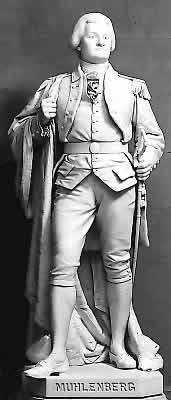
Back پيتير موهلينبيرج ARZ Peter Muhlenberg Danish Peter Muhlenberg German پیتر موهلنبرگ Persian Peter Muhlenberg French Peter Muhlenberg Hungarian ピーター・ミューレンバーグ Japanese Peter Muhlenberg Polish Мюленберг, Джон Питер Гэбриэл Russian Peter Muhlenberg Swedish
Peter Muhlenberg | |
|---|---|
 | |
| United States Senator from Pennsylvania | |
| In office March 4, 1801 – June 30, 1801 | |
| Preceded by | William Bingham |
| Succeeded by | George Logan |
| Member of the U.S. House of Representatives from Pennsylvania's 4th district | |
| In office March 4, 1799 – March 4, 1801 | |
| Preceded by | John Chapman |
| Succeeded by | Isaac Van Horne |
| Member of the U.S. House of Representatives from Pennsylvania's at-large district | |
| In office March 4, 1793 – March 4, 1795 | |
| Preceded by | Constituency established |
| Succeeded by | Constituency abolished |
| In office March 4, 1789 – March 4, 1791 | |
| Preceded by | Constituency established |
| Succeeded by | Constituency abolished |
| 8th Vice-President of Pennsylvania | |
| In office October 31, 1787 – October 14, 1788 | |
| President | Benjamin Franklin |
| Preceded by | Charles Biddle |
| Succeeded by | David Redick |
| Personal details | |
| Born | John Peter Gabriel Muhlenberg October 1, 1746 Trappe, Pennsylvania, British America |
| Died | October 1, 1807 (aged 61) Grays Ferry, Philadelphia, Pennsylvania, U.S. |
| Political party | Democratic-Republican |
| Relations | Muhlenberg family Conrad Weiser (maternal grandfather) |
| Profession | Minister, Politician, Soldier |
| Signature | |
| Military service | |
| Allegiance | |
| Branch/service | |
| Years of service | 1776–1783 |
| Rank | |
| Commands | 8th Virginia Regiment |
| Battles/wars | |

John Peter Gabriel Muhlenberg (October 1, 1746 – October 1, 1807) was an American clergyman and military officer who served during the American Revolutionary War. A member of Pennsylvania's prominent Muhlenberg family political dynasty, he became a respected figure in the newly independent United States as a Lutheran minister and member of the United States House of Representatives and United States Senate.[1]
- ^ Kennedy, Will P. "Capital Sidelights." Washington, D.C.: The Sunday Star, October 11, 1942, p. 27 (subscription required).